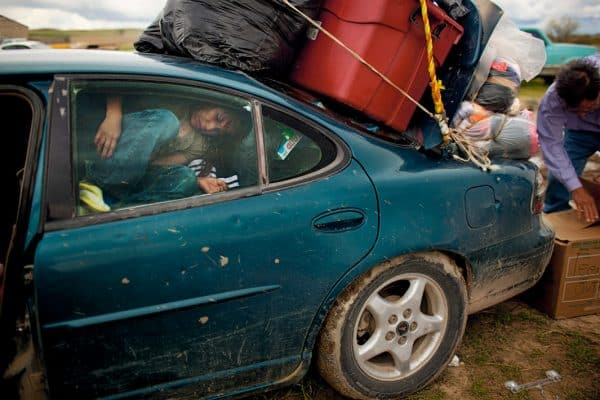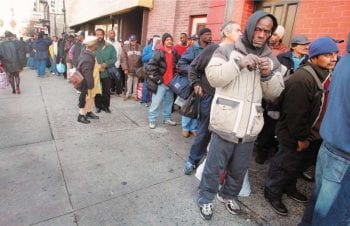![]() Paul Street
Paul Street
A Strong Left Voice in Middle America
One common reference point, the U.S. federal poverty level, is sorely inadequate to the task. It has two basic flaws. First of all, it is absurdly low, based as it is on a hopelessly antiquated 1950s formula that multiplies a minimum food budget three times. The formula made a certain miserly sense when it was set in 1955 (when the average U.S. family actually did spend one third of its budget on food), but it is wholly inappropriate today. The minimum required outlays for rent, transportation, child care, health insurance, medical care have since risen significantly both in absolute terms and as a percentage of U.S. household expenditures.
Here’s the federal poverty level right now: one person in a household: $11,770; two persons: $15,930; three (say, one parent and two children): $20,090; four (say, two parents and two children): $24,250; five: $28,410; six: $32,750. I defy any household that does not grow its own food and manufacture its own clothes and medicine while foregoing modern health care, insurance, telecommunications, and transportation, to try to live with minimum basic level of comfort and health at these levels.
A second major flaw in the U.S. poverty level is that that it is not adjusted for significant geographic variations in the cost of living across US metropolitan areas. It costs considerably more to get by in Chicago or New York City than it does in “downstate” rural Illinois or “upstate” New York. It is much more expensive to live in San Francisco than it is in Bakersfield, California.
What does it cost just to get by in the U.S. today? It depends on where you live, to no small extent. In an all-too rare example of real social use value resulting from the labor of intellectuals, researchers at the Economic Policy Institute (EPI) have done some remarkable work on this topic. They have calculated the varying minimum no-frills “income required to afford an adequate standard of living” for six family types living in 615 specific U.S. communities, taking into account the varying costs in each of community of seven basic expenditures: housing, food, transportation, child care, health care (premiums plus out of pocket expenses), “other necessities” (clothing, personal care, household supplies, reading materials, school supplies, telephone), and taxes.
According to the EPI Family Budget Calculator, the real cost of a minimally adequate no-frills standard of living for one parent with one kid in Iowa City, Iowa (where I currently reside) is $48,235 – more than three times the official U.S, poverty level for a two person household! That sounds high until you add up the monthly expenses: housing ($853), food ($369), child care ($684), transportation ($459), health care ($891), other necessities ($313), and taxes ($450), for a total monthly outlay of $4,020. Go to the San Francisco metropolitan area and the cost of a basic family budget for one parent with one kid is $70,929 (compared to $46,989 in Bakersfield), more than four times higher than the federal poverty measure. In the Chicago area, it’s $53,168. Even over in depressed Rockford, Illinois, its $48,936. In rural Illinois, its $48,129. Make it two parents and two kids in Iowa City, Iowa, and the cost is $66,667 – 275% of the federal poverty level for a four- person household.
With most Americans’ wages stagnating for more than a decade and with the lowest paid workers’ wages shrinking, is it any wonder that half of the more than 24 million Americans who rely on food banks for basic nutrition are employed?
The EPI’s figures are worth keeping in mind the next time you hear the Chamber of Commerce or the American Enterprise Institute express horror at the notion that the minimum wage should go as “astronomically” high as $15 an hour. Even such a dramatically increased minimum wage translates into just $30,000 a year for a worker fortunate enough to stay employed full time.

Heading home with aid for reservation families (Teicher.)
Put two parents with two children successfully in the job market full time and you still come up $6, 667 short in Iowa City, where the local Proctor and Gamble plant is currently hiring (through an employment firm called Staff Management/SMX) warehouse and production workers for just over $10 an hour ($20,000 per years if able to get full time hours year round).
Considering all this, I can be forgiven, perhaps, for not showering praise on my local county (Johnson County, Iowa) board of supervisors for agreeing (under pressure from local labor activists) to consider a proposed ordinance that would raise the county’s minimum wage from $7.25 to $10.10 an hour by 2017 in three 95-cent increments. To be sure, the current U.S. minimum wage of $7.25 an hour is another bad joke. (If it had kept pace with increases in U.S. labor productivity since the 1970s, it would be $18 an hour today. At its current level, it translates [assuming full-time year round work] into $14,500 per year, well below the horrific federal poverty level for a three-person family.)
It’s good to see local city councils and now even (in this case) a county board experiment with going beyond the federal minimum wage. The precedent is most welcome. But, please, just ten dollars an hour… $20,000 a year, assuming full-time year round work (which many workers cannot attain)…and this just by 2017? Forget for a moment that many employers in the area (I’ve been sampling the bottom end of the local labor market as a job applicant in recent weeks) are already at or above $10 an hour. That aside, the EPI’s carefully calculated basic family budget even just for one parent and one kid in Iowa City (Johnson County’s biggest municipality) is over $48,000 per year. That’s more than 240 % of what someone can make at a measly ten dollars an hour. The so-called People’s Republic of Johnson County is currently “feeling the Bern” (the passion for nominally socialist Democratc presidential candidate Bernie Sanders) more intensely than any county in America. Could its whole county board please join one of its members (Mike Carberry) by having the basic decency to Fight for Fifteen?
![]()
 ndependent radical-democratic policy researcher, journalist, historian, author and speaker based in Iowa City, Iowa, and Chicago, Illinois. He is the author of seven books to date, including: Empire and Inequality: America and the World Since 9/11 (Boulder, CO: Paradigm, 2004); Racial Oppression in the Global Metropolis: a Living Black Chicago History (New York: Rowman & Littlefield, 2007); The Empire’s New Clothes: Barack Obama in the Real World of Power (Paradigm, 2010); (with Anthony DiMaggio) Crashing the Tea Party: Mass Media and the Campaign to Remake American Politics (Paradigm, 2011); They Rule: The 1% v. Democracy (Paradigm, September 2014). His essays, articles, reviews, interviews, and commentaries have appeared in numerous outlets political, media, and academic. Visit his website, Paul Street
ndependent radical-democratic policy researcher, journalist, historian, author and speaker based in Iowa City, Iowa, and Chicago, Illinois. He is the author of seven books to date, including: Empire and Inequality: America and the World Since 9/11 (Boulder, CO: Paradigm, 2004); Racial Oppression in the Global Metropolis: a Living Black Chicago History (New York: Rowman & Littlefield, 2007); The Empire’s New Clothes: Barack Obama in the Real World of Power (Paradigm, 2010); (with Anthony DiMaggio) Crashing the Tea Party: Mass Media and the Campaign to Remake American Politics (Paradigm, 2011); They Rule: The 1% v. Democracy (Paradigm, September 2014). His essays, articles, reviews, interviews, and commentaries have appeared in numerous outlets political, media, and academic. Visit his website, Paul Street
=SUBSCRIBE TODAY! NOTHING TO LOSE, EVERYTHING TO GAIN.=
free • safe • invaluable





